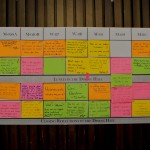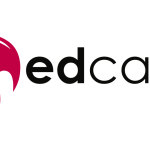“If you have an apple and I have an apple and we exchange these apples then you and I will still each have one apple. But if you have an idea and I have an idea and we exchange these ideas, then each of us will have two ideas.”
-George Bernard Shaw
This past week, I opened our first District Edcamp by using the above quote to illustrate that the sharing of ideas can lead to improved learning outcomes. Once an idea is realized, there is no telling where that idea can take a person. This was the goal for our District Edcamp, to empower teachers to share ideas and to inspire and learn from one another. Early feedback indicates that the goal was met and that the Edcamp model provided important and meaningful PD for teachers. One teacher called it the “best PD I’ve ever had.” Another teacher said that she would be able to take ideas back to her classroom, as opposed to previous PD sessions which she felt weren’t relevant to her classroom. In the days that have followed, I’ve been reflecting on what makes such an event successful. Below are some of my reflections:
Choice really does matter. I talked to a number of teachers who were very excited about having the ability to choose which sessions they would attend. Just as choice helps students to become more engaged in the learning process, choice for teachers can support engagement in professional learning. In looking back at the number of PD sessions I have attended over the years, I’ve come to recognize that the presenter certainly received more buy-in from me when I was engaged in the topic. When I was forced to sit through a session that didn’t meet my needs, I was often disinterested at best. At Edcamp, teachers were provided with an opportunity to attend one of fourteen sessions during each timeslot. Providing a wide variety of workshops, and the freedom to choose sessions, helps to ensure that teachers receive information and resources that are relevant to their classrooms, needs, or interests.
Giving educators time to share is important. We purposefully built in 20 minutes between sessions and a longer lunch period so that teachers could share. It was important to us that teachers were truly collaborating and exchanging ideas during the event. Too often, teachers are confined to their classrooms, rarely having the opportunity to share with colleagues. Lunchtime often becomes an important meeting time for colleagues. Throughout our Edcamp event, I heard important conversations and reflection going on in the hallways and during lunch. Teachers talked about what they had just learned, shared a lesson idea, and discussed how they would be implementing into their classrooms. Speaking of which…
Teachers are looking for ideas that can be implemented in the classroom immediately. Much of the sharing at our Smackdown sessions focused on websites, resources, and strategies that teachers were excited to implement in their classrooms. Traditional PD often requires numerous sessions before a teacher can begin implementation in the classroom. Sometimes, whole group training might not be relevant in certain classrooms. At Edcamp, staff members chose which topics they wanted to learn about. In many cases, they chose to learn about resources that would work in the classroom the next day, such as apps like Plickers or Zipgrade. Discussion based sessions led by our guidance counselors and special education teachers gave colleagues ready-to-use strategies for behavior issues in the classroom.
Educators value learning from their colleagues. Over 40 presenters facilitated more than 27 different sessions throughout the day. Much of the feedback that I heard was how much teachers enjoyed learning from their colleagues. In “one and done” presentations, a presenter from outside the district shares and is not able to provide follow-up. The Edcamp model allows teachers to present their ideas in a collaborative forum and to become an ongoing contact and resource. Here, staff members learned from each other, and can continue to collaborate and learn from each other. The exchange of ideas among colleagues helps to inspire development and learning beyond PD sessions. Just as the traditional Edcamp set-up inspires educators to become “connected” using social media, it is important to encourage colleagues to become “connected” with one another as well.
Movement and physical interaction helps to engage educators. During traditional PD days in the past, educators were subjected to 2-3 hour sessions in the same room with 10 minute “stand and stretch” breaks. During our Edcamp, teachers were moving to a new classroom every 45 minutes. I attended a session at our Edcamp called “You Too Can Move.” The session focused on the benefits of including short “brain breaks” in the classroom, which are opportunities for students to stand up in between lessons to incorporate movement throughout the school day. These brain breaks help to rejuvenate students and to inspire engagement in daily activities. Similarly, sessions on how to create purposeful movement and activity through yoga and through the use of music and storybooks helped to illustrate how movement can focus students’ attention on content area skills. While reflecting on these sessions, it dawned on me that this is exactly why Edcamp works so well. The movement between and during workshops helps to keep staff actively engaged in the day!
A quote from an anonymous author says, “If you are the smartest person in the room, you are in the wrong room.” With the growing popularity of Edcamps, I believe that this prevailing thinking has changed with regard to professional learning. The smartest person in the room IS the room! Important development and learning can take place through collaboration and sharing among colleagues, which helps to make professional learning more relevant and specific to needs, interests, and goals. Educators across the world have embraced the Edcamp model because they ARE Edcamp!
By Rich Czyz @RACzyz





Pingback: Edcamp | Pearltrees
Pingback: Is it meaningful? Is it relevant? | 4 O'Clock Faculty